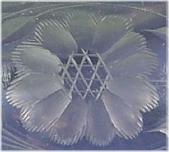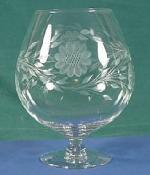National Depression Glass Association
Preserving America's Glass Manufacturing Heritage
Hughes Corn Flower: An Elegant Canadian Tradition
By Walter Lemiski M.A.

 The founder of the W.J.
Hughes Corn Flower Company, William John Hughes, was born in
Dufferin County, Ontario in the early 1880's. As a young man he was
employed by Roden Brothers silversmiths of Toronto in the 1890's.
Fortunately for him and for glass collectors, when that firm
expanded their lines to include cut lead glass Hughes was asked to
learn the art of cutting. Starting in 1912, he began to experiment
at his home with his own original "grey" cut glass patterns
(shallower cuts on lighter glass). In 1914, Hughes left Roden
Brothers to devote himself full time to producing and selling Corn
Flower glass. As can be seen in the closeup at left, the Hughes Corn
Flower pattern is distinctive with
its petalled flower, grid like interior and elegant sweeping stems as
seen in the photo at right.
Care was taken to maintain the integrity of the pattern throughout
the three quarters of a century of production life. The
hand-cutting of Corn Flower was done in a five step process:
The founder of the W.J.
Hughes Corn Flower Company, William John Hughes, was born in
Dufferin County, Ontario in the early 1880's. As a young man he was
employed by Roden Brothers silversmiths of Toronto in the 1890's.
Fortunately for him and for glass collectors, when that firm
expanded their lines to include cut lead glass Hughes was asked to
learn the art of cutting. Starting in 1912, he began to experiment
at his home with his own original "grey" cut glass patterns
(shallower cuts on lighter glass). In 1914, Hughes left Roden
Brothers to devote himself full time to producing and selling Corn
Flower glass. As can be seen in the closeup at left, the Hughes Corn
Flower pattern is distinctive with
its petalled flower, grid like interior and elegant sweeping stems as
seen in the photo at right.
Care was taken to maintain the integrity of the pattern throughout
the three quarters of a century of production life. The
hand-cutting of Corn Flower was done in a five step process:
- "Spotting" - marking out the positioning of the flowers with dash-like cuts
- "Six-siding" and "stemming" - the interior grid-like design of authentic Corn Flower forms hexagonal patterns; graceful arching stems also were cut in this stage
- "Leafing" - distinctive leaves formed with a pair of elongated semi-circles that end in a point
- "Petalling" - a series of shallow cuts usually forming twelve petals, however this number did vary when space was restricted on smaller surfaces. On items with very little room a Corn Flower bud design was used
- "Fringing" or "nicking" - the tips of the petals were decorated with a series of small cut lines
Identification of the glass blanks that the Hughes Corn Flower Company used proves to be no mean feat since their glass was imported from many different firms over the years. Prior to World War II the lion's share of glass was ordered from the United States. The companies included were Cambridge, New Martinsville, Louie, Fostoria, Imperial, Duncan and Miller, Indiana, West Virginia Glass Specialty, and Mid-Atlantic Glass Companies.
With the onset of WWII American glass became more difficult for the Hughes Corn Flower Company to import. Even after the war, in the mid-1940's, glass manufacturers in the States could not keep up with the rebound in domestic demand, let alone supply the Canadian market. The Hughes' were forced to look elsewhere and therefore turned to Europe to take up the slack for mouth-blown glassware. European glass was imported from Belgium, Czechoslovakia, Germany, Hungary, Rumania, and Sweden. Importing from Europe also was not without its challenges. Quality, quantity and timely delivery were all matters of concern for the Hughes Corn Flower Company.
The most constant source of glass blanks for Corn Flower over the years was the Imperial Glass Company, established in 1901, in Bellaire, Ohio. Imperial's Line #400, best known as Candlewick, was a favourite medium for the Hughes Corn Flower cut. Introduced in 1936, this line flourished until the closure of the Imperial Glass Company in 1986. Three main reasons exist for the long working relationship that Corn Flower enjoyed with Imperial. First of all, the quality of Candlewick in its consistency and clarity made it excellent for cutting. Secondly, the number of items in this huge line of blanks, numbering some three hundred in all over the years, gave a fine selection of pieces with ample smooth surface area for working. Lastly the Candlewick line was in production for an astoundingly long period of time, fifty years. Ed Kleiner, the Imperial Glass Company's sales representative for Canada through to the mid-1950's, stated that only once in his career did he receive an order for an entire boxcar-load of Candlewick - that order was shipped to Hughes Corn Flower Limited.
The business had started on a rather small scale. Indeed for most of the first thirty-some years the production of Corn Flower was done from the basement of the family's home. W.J. Hughes would receive barrel shipment of glass, cut the glass, and then go on the road to sell and deliver the product to various outlets. The retailers of Corn Flower included china and gift shops, jewellers and major department stores such as Eatons and Simpsons. Customers could also visit the showroom at the house to purchase available items. Through the thirties and most of the forties Hughes Corn Flower kept a handful of cutters busy producing their trademark glassware. In 1945, Phillip "Pete" Kayser, W.J. Hughes' son-in-law, started to work part-time for the firm [he had married W.J.'s daughter Lois]. By 1951, it was Pete who was running the business. The company's growth from that time on was astounding. By the early fifties, sixteen cutters were on staff at the Kenwood Avenue factory.
At the height of the Hughes Corn Flower Company's production there were no fewer than thirty cutters, and in all some eighty staff, employed at the company's Tycos Drive plant.
Thousands upon thousands of households right across Canada have cherished Corn Flower for generations. Many are the stories of Canadians who remember saving to buy pieces of this lovely glassware, being given Corn Flower as a present on special occasions, or having had it handed down to them as a family heirloom. The longevity of this beautiful glassware, in production for three quarters of a century from 1912 to 1988, in itself serves as a tribute to the Hughes Corn Flower Company. W.J. Hughes Corn Flower is indeed a truly amazing Canadian success story.
Webmaster's Note: Walter Lemiski is the president of the Canadian Depression Glass Association and also has his own web site, Waltz Time Antiques. He has graciously permitted us to use this article on the NDGA web site.
To get an idea of the beauty and variety of this pattern, click on any of the thumbnail pictures below to see a larger, more detailed image.
![Corn Flower [Cambridge]: amber](tn_cfcambridge933.jpg)
![Corn Flower [Central]: amber](tn_cfcentralbowl.jpg)
![Corn Flower [Duncan Miller]: crystal](tn_cfteardrop.jpg)
![Corn Flower [Duncan Miller]: green](tn_cfduncan6.jpg)
![Corn Flower [European Boule]: crystal](tn_cfbeadedvase.jpg)
![Corn Flower [New Martinsville]: crystal](tn_cfradiancemayo2.jpg)
![Corn Flower [Federal]: Milk glass](tn_cfcasserole.jpg)
![Corn Flower [Heisey]: Flamingo](tn_cfwabash3350.jpg)
![Corn Flower [Imperial]: crystal](tn_cffanvase.jpg)
![Corn Flower [Lancaster]: Pink](tn_cflancasterpink.jpg)
![Corn Flower [Tiffin]: Yellow](tn_cftiffin.jpg)
![Corn Flower [United States Glass Co.]: pink](tn_cfus9574.jpg)
![Corn Flower [West Virginia Specialty]: crystal](tn_cfbrandyvase.jpg)